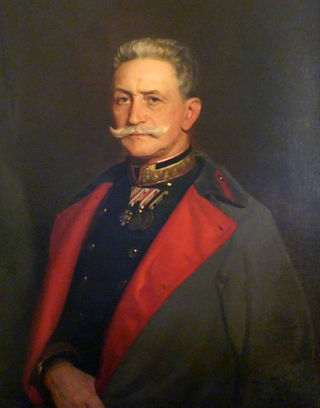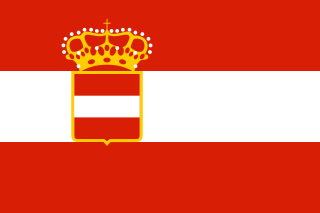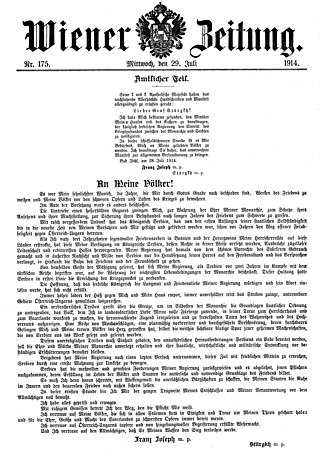Related Research Articles

Austria-Hungary, also referred to as the Austro-Hungarian Empire, the Dual Monarchy or the Habsburg Monarchy, was a multi-national constitutional monarchy in Central Europe between 1867 and 1918. A military and diplomatic alliance, it consisted of two sovereign states with a single monarch who was titled both Emperor of Austria and King of Hungary. Austria-Hungary constituted the last phase in the constitutional evolution of the Habsburg monarchy: it was formed with the Austro-Hungarian Compromise of 1867 in the aftermath of the Austro-Prussian War and was dissolved shortly after Hungary terminated the union with Austria on 31 October 1918.

Franz Xaver Josef Conrad von Hötzendorf, sometimes anglicised as Hoetzendorf, was an Austrian general who played a central role in World War I. He served as K.u.k. Feldmarschall and Chief of the General Staff of the military of the Austro-Hungarian Army and Navy from 1906 to 1917. He was in charge during the July Crisis of 1914 that caused World War I.

Leopold Anton Johann Sigismund Josef Korsinus Ferdinand Graf Berchtold von und zu Ungarschitz, Frättling und Püllütz was an Austro-Hungarian politician, diplomat and statesman who served as Imperial Foreign Minister at the outbreak of World War I.

The Second Battle of the Piave River, fought between 15 and 23 June 1918, was a decisive victory for the Italian Army against the Austro-Hungarian Empire during World War I, as Italy was part of the Allied Forces, while Austria-Hungary was part of the Central Powers. Though the battle proved to be a decisive blow to the Austro-Hungarian Empire and by extension the Central Powers, its full significance was not initially appreciated in Italy. Yet Erich Ludendorff, on hearing the news, is reported to have said he 'had the sensation of defeat for the first time'. It would later become clear that the battle was in fact the beginning of the end of the Austro-Hungarian Empire.

The Austro-Hungarian Army, also known as the Imperial and Royal Army, was the principal ground force of Austria-Hungary from 1867 to 1918. It consisted of three organisations: the Common Army, the Imperial-Royal Landwehr and the Royal Hungarian Honvéd.

Ludwig August Ritter von Benedek, also known as Lajos Benedek, with the Hungarian form of Ludwig, was an Austro-Hungarian general (Feldzeugmeister), best known for commanding the imperial army in 1866 in their defeat at the Battle of Königgrätz against the Prussian Army, which ended his career.
Konrad is a German given name and surname that means "bold counselor" and may refer to:

The Hofkriegsrat established in 1556 was the central military administrative authority of the Habsburg monarchy until 1848 and the predecessor of the Austro-Hungarian Ministry of War. The agency was directly subordinated to the Habsburg emperors with its seat in Vienna.

The Military Merit Medal was a military decoration of the Empire of Austria-Hungary. It was founded by Emperor Franz Joseph I on March 12, 1890. The Military Merit Medal is often referred to as the "Signum Laudis" after the inscription on the reverse of the medal.

The k.u.k. Evidenzbureau was the directorate of military intelligence of the Austro-Hungarian Empire, headquartered in Vienna, Austria.

The Imperial and Royal Minister of War, until 1911: Reich Minister of War, was the head of one of the three common ministries shared by the two states which made up the dual monarchy of Austria-Hungary from its creation in the Compromise of 1867 until its dissolution in 1918.

The Hietzing Cemetery is a cemetery in Hietzing, the 13th district of Vienna.

The Imperial and Royal Foreign Ministry was the ministry responsible for the foreign relations of the Austro-Hungarian Empire from the formation of the Dual Monarchy in 1867 until it was dissolved in 1918.

Café Sperl is a traditional Viennese café located at Gumpendorfer Straße 11 in the Mariahilf sixth district of Vienna, Austria. The café is on the Austrian Register of Historic Places.

Friedrich Graf von Beck-Rzikowsky, sometimes Friedrich Beck, was an Austrian Generaloberst and Chief of the general staff of the Imperial and Royal Army of Austria-Hungary from 1881 to 1906.

The Common Army as it was officially designated by the Imperial and Royal Military Administration, was the largest part of the Austro-Hungarian land forces from 1867 to 1914, the other two elements being the Imperial-Royal Landwehr and the Royal Hungarian Honvéd. However, it was simply known as the Army (Heer) by the Emperor and in peacetime laws, and, after 1918, colloquially called the k.u.k. Armee.

The Supreme Commander of the Imperial and Royal Armed Forces was the ultimate authority of the Austro-Hungarian Armed Forces – which comprised the Army, Navy and Aviation Troops of Austria-Hungary.

The 2nd Army, later designated East Army, was a field army-level command of Austro-Hungarian Army that was active during World War I. It was initially formed to take part in the Balkans Campaign before being transferred to the Eastern Front. In the final stages of the war, the army was evacuated from Ukraine before demobilizing in November 1918.

The Imperial and Royal General Staff of Austria-Hungary was part of the Ministry of War. It was headed by the Chief of the General Staff for the Whole Armed Forces, who had direct access to the Emperor.

On 28 July 1914, Austria-Hungary declared war on Serbia because of the Assassination of Archduke Franz Ferdinand. Within days, long-standing mobilization plans went into effect to initiate invasions or guard against them and Russia, France and Britain stood arrayed against Austria and Germany in what at the time was called the "Great War", and was later named "World War I" or the "First World War". Austria thought in terms of one small limited war involving just the two countries. It did not plan a wider war such as exploded in a matter of days.
References
- ↑ Langenscheidt`s Encyclopaedic Dictionary of English and German Language “Der Große Muret-Sander“, Part II, German-English, First Volume A–K, 9th edition 2002, page 955
- ↑ Rothenberg, Gunther E. (1976). The Army of Francis Joseph. West Lafayette: Purdue University Press. pp. 12–13. ISBN 978-1-61249-067-0. OCLC 566000164.
- ↑ Rothenberg 1976, p. 12.
- ↑ Rothenberg 1976, p. 143.
- ↑ Sondhaus, L. Franz Conrad von Hötzendorf: Architect of the Apocalypse. (Studies in Central European Histories.) Boston: Humanities Press, 2000. p 37. (Retrieved via Google Books 2/23/11.)